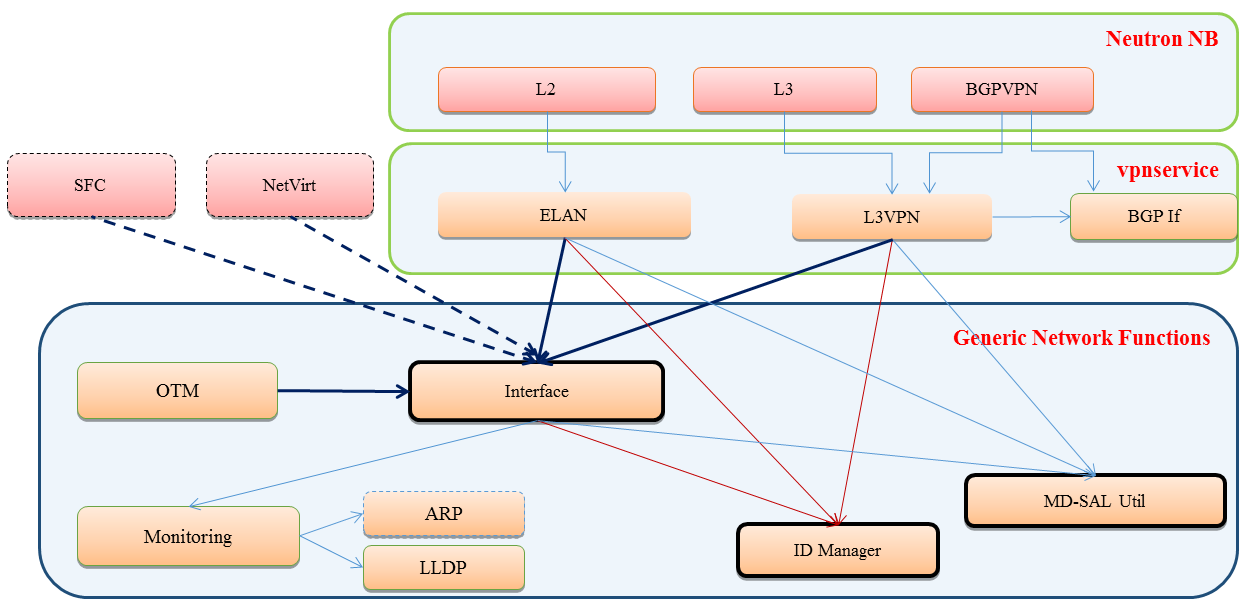Content
Background
Application Co-existence and Integration Challenges
Partitioning of OpenFlow Resources
- Every application must have their private flow state space (on every switch)
- Flow tables, group table, meter table, cookies
- Every application must have their private flow state space (on every switch)
- Ingress demultiplexing (aka “Table 0 Problem”)
- Packets entering the switch have to be directed to the correct application pipeline
- Applications cannot simply write ingress flow entries into table 0 without coordination
- Need smaller granularity than OF port (e.g. VLAN, VNI, etc)? generalized interface concept
- Co-existence of multiple applications on the same interface
- Multi-tenancy: Several isolated service instances of the same application
- Integration/Co-operation of different applications
- Control plane: Service APIs between applications
- Data plane: Transfer packets between the pipelines of different applications
- Take the use of various packet metadata into account!
- Each application comes with its own overlay solution
Case-by-Case Approach
- Chosen approach in ODL Beryllium between SFC, GPB and Netvirt
- Partitioning of OpenFlow Resources
- Design time coordination between different applications
- Ingress demultiplexing (aka “Table 0 Problem”)
- All application write into table 0, but the flow entries and priorities have been agreed at design time to avoid unwanted interference
- Integration/Co-operation of different applications
- Control plane: MD-SAL service APIs between applications?
- Data plane: Direct GOTO Table to transfer the packet from one application pipeline to another
- Partitioning of OpenFlow Resources
- Analysis
- Can lead to an optimal solution for a group of specific applications
- Design time coordination needed for every detail
- Hard-coded dependencies between applications
- Does not scale to many applications
Ingress De-multiplexing
- Multiple applications writing into table 0 (directly or through an Ingress Manager function)
- Flow conflict detection mechanisms do not allow for any overlap between flows
- Overlap (or rather refinement) should be allowed using priorities to disambiguate:
- e.g. packets on in_port with certain DMAC to application A, all the rest to application B
- How can a generic Ingress Manager ensure that there is no semantic conflict between the flows if the simple non-overlap criterion is not sufficient?
Genius Proposal
Generic Functions for Multi-Network Service Support
- Any ODL application can use these to achieve at minimum interference-free co-existence with other applications using the services
- Provide support for co-operation between applications with the minimal amount of design-time coordination and hard-coded dependencies
- Use APIs to move design-time coordination to run-time
- Generic infrastructure APIs to avoid direct coupling where possible
- Direct inter-application (client-server) APIs where necessary for stronger coupling
- Factor out commonly used functions into shared services to avoid duplication & waste of resources, e.g.
- Overlay Tunnel Manager
- ID manager
- MD-SAL Util
VPN Service Modules and Inter-relationships
Interface Manager
- Models generic interfaces as attachment point for applications
- Supports Hierarchy of: Port, VLAN, VXLAN Trunk, VXLAN VNI, GRE Tunnel, ...
- Extendible to arbitrary other types of interfaces (virtual link, VPN interface, …)
- Interface ID/tag system wide unique identifier in control/data plane.
- Ingress interface tag stored in metadata
- Handles ingress de-capsulation and de-multiplexing
- Owns table 0 (and possibly additional tables needed for demultiplexing of interfaces)
- Application bind to interfaces through API and register application-specific instructions/actions to be added to the interfaces ingress flow entry (e.g. write metadata, goto table)
- Each bound service is assigned to a separate interface handle, no risk of interference on ingress traffic
- South bound protocol agnostic
- Ability to plug in different south bound renderers
- Provides tunnel monitoring services
- Handles egress encapsulation and output, service processing priority


